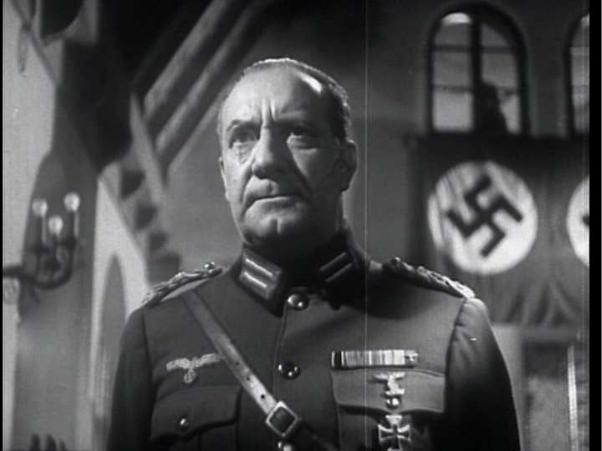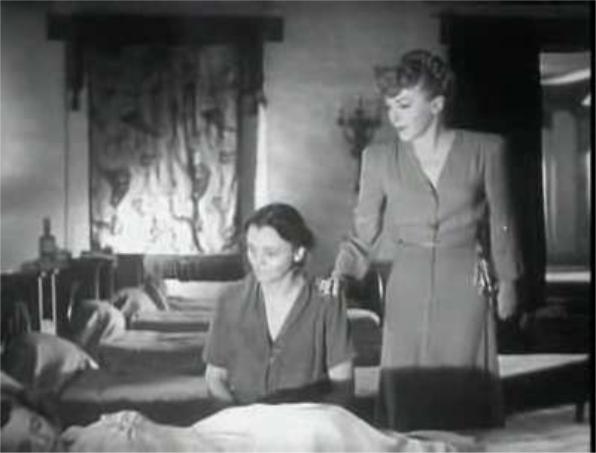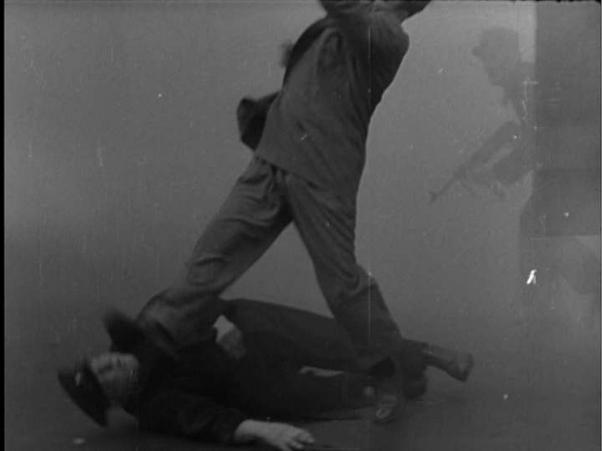
WilliamsT
.pdf
Chapter III
Part One
Travelling Light: A Return to Work in Europe, 1948 - 1959
Part Two
Case Study: The Cinematographic Representation of the Asylum
Space
191

Part One
Travelling Light: A Return to Work in Europe, 1947-1959
Following his work with Robert Siodmak on The Dark Mirror, it would seem that a taste of larger studio productions left Schüfftan tired of smaller budget films and the lack of freedom they – and work in America – offered him. Offers from Paris, where Schüfftan could work – liberated from the constraints of the ASC and once again be recognised for his brilliance as a cinematographer – clearly were now more appealing to him. One project remained for Schüfftan in the United States, reuniting him with Ulmer for Carnegie Hall, a celebration of classical music. Schüfftan did not, however, act as cinematographer, instead taking his credited role for ‘Production Technique’. Edgar Ulmer has given us clear indication as to why Schüfftan did not act as cinematographer when he comments that, ‘you can tell by the cameraman I had on the picture if I took a picture very seriously or not. For my serious pictures I always had Schuftan’ (in: McCarthy and Flynn, 1975: 401). Therefore, for this light-hearted celebration of New York musical theatre it would seem that Ulmer assumed
192
Schüfftan to be inappropriate, suggesting the degree to which Schüfftan had become unavoidably associated with the stark and dramatic lighting styles of the Expressionist movement, even amongst his émigré colleagues. Such an assumption on the part of Ulmer ignores the variety of Schüfftan’s technique, and his successful lighting in comedies such as
Du Haut en bas (1933) and La Tendre ennemie (1935). Even if Ulmer had not trusted
Schüfftan’s variety, this would be tested for the cinematographer in the late 1940s and 1950s, when it was necessary for him to turn his hand to photographing a whole host of different genres in a variety of nations.
As an indication of Schüfftan’s weariness of union blackballing, he wrote to his friend Siegfried Kracauer on February 24th 1947, asking the writer to give him the option on a film treatment he had written based on the life of composer Jacques Offenbach. Schüfftan intended to turn the treatment into a musical film, seeing the opportunity to move into the field of producing. Nothing came of this endeavour, although the very same letter notes that the Schüfftans had finally been awarded their American citizenship: 'Friday, Febr. 28 the great day arrives where we become citizen, after all we deserve it. Due to “friendly neighbours” our affair was a little “cloudy” but now everything is settled and the sun is coming out. I should say it is not very agreeable' (Schüfftan in: Asper, 2003a: 71).
With the newfound freedom granted by the pending citizenship, Schüfftan felt able to accept a job on a production in Mexico called Women in the Night (William Rowland), arranged in the final months of 1946. The film marked the beginning of what can be considered a rather nomadic (to the extent of seemingly schizophrenic) period in the career of Eugen Schüfftan, in which he travelled between France, Spain, Italy, Switzerland, Canada, Mexico and New York for his filmmaking projects, and performed his duties upon a wide variety of different genres. It was a period characterized by the Schüfftans in 1950 as ‘a real gipsy life [sic.]’ (in:
193
Asper, 2003a: 89), and can be seen as a consequence of their failure to settle in any country thus far. Having survived the Nazi terror in Europe, even the United States had failed to offer Schüfftan the opportunities he expected. This chapter sets out to address this rather unsettled time in the Schüfftans’ lives, and examines Schüfftan’s shifting stylistic approaches across the many nations and genres he worked in, before he finally found some direction at the end of the 1950s through his collaborations with Georges Franju.
Nomad’s Land
The lure of film production beyond the United States borders was that it finally allowed Schüfftan to have full control over cinematography. For the first of these films, Women in the Night, in a letter to the Kracauers, Marlise Schüfftan noted a number of difficulties which this caused her and her husband, whom she affectionately refers to as ‘Shiffy’:
I am a straw-widow due to the fact that there would have been to [sic] many difficulties for me to cross the border. Shiffy had to fill out a lot of sheets for his re-enter permit which they had to go to Washington before he could leave Tuesday a week ago. Yesterday they started shooting I am so happy that he is the first cameraman and can dictate as he likes. (Schüfftan in: Asper, 2003a: 69)
The film is the story of a group of women from the various Allied nations who are studying at the University of Shanghai. They are arrested on an unjustified charge of murder of a German officer and are used by the Germans as sexual slaves to satisfy their Japanese allies. The German and Japanese plot is complicated, however, by the presence of a number of spies amongst the group of girls. Schüfftan’s first chance for around seven years to dictate as he would like and take full charge of the cinematography saw him opt for a strong use of the stylistic techniques that we know he had come to favour, such as Rembrandt lighting. In this
194

film Schüfftan avails himself of at least two Rembrandt lighting techniques. First is Rembrandt’s classic composition of lighting faces, which we have seen Schüfftan employ throughout his career. This is particularly evident in mid-shots of the German officers such as Von Meyer (Gordon Richards), whereby shadow is cast across one side of the face, leaving Rembrandt’s classic triangle of light under the eye (see Figure 41).
Figure 41: Rembrandt lighting in Women in the Night.
Schüfftan’s other established techniques are also apparent throughout, such as a more diffused lighting and softer focus for the female characters, which creates a contrast between the innocent female victims, and the harder lighting of the German officers. The second Rembrandt technique favoured by Schüfftan in the film is to create depth in the mise-en- scène. This is achieved by casting a bright spotlight onto the background set, away from the
195

subjects of the frame (Figure 42). This creates a form of narrative in the image, whereby the viewer’s eye is drawn from the brightest point of the set in the background, across the subjects of the frame in the foreground. We have seen Schüfftan employ both of these Rembrandt techniques previously in his career, however it is highly significant that when, for the first time since 1940, Schüfftan is afforded the opportunity to take full control of cinematography, he reverts to these techniques as his stylistic core.
Figure 42: Schüfftan employs Rembrandt's depth techniques in Women in the Night.
Having failed to make any headway with Kracauer's treatment of Offenbach, once his his American citizenship came through, Schüfftan chose to pursue projects outside of the United States, having presumably relished the creative freedom that Women in the Night had offered him. The Schüfftans therefore continued their nomadic journey by travelling to Rome in the
196

Autumn of 1947, marking Schüfftan’s first return to European filmmaking since he had fled to America at the start of the decade. Rather, it would have marked Schüfftan’s return to
European filmmaking, had the project not been beset with delays, resulting in the film eventually being cancelled before filming had even begun (it is not known what the failed project concerned).
From Rome, Schüfftan's next project saw him head to Montreal, Canada, in the summer of 1948. Explaining to the Kracauers their reasons for being in Canada, Marlise wrote that her husband 'has a contract here for 6 months, the Renaissance Studio, the only one here in town, is brand new und [sic] he has to build it up in American style' (in: Asper, 2003a: 73). Therefore, despite having spent only around five years working on Poverty Row, Schüfftan was considered to be an expert in the construction of the American studios. There is not a little irony involved here, with Schüfftan being deemed by non-American studios to have the relevant expertise of an American cinematographer. However, it would lead to him making a number of American-influenced films in Europe throughout the 1940s and 1950s. At one point, cruellest of ironies, this supposed status as an American cinematographer briefly proved to be something of a barrier to finding work in France.
What was initially a 6 month contract in fact saw Schüfftan remain in Canada until 23rd
February, 1949, although he did not work upon any film productions during this time, being only responsible for establishing the set-up of the studio. A number of opportunities presented themselves to Schüfftan, including an offer from Orson Welles to shoot his version of Othello in Paris, an unrealised Abel Gance film entitled La Tragèdie divine, and work on Jean Renoir's film The River, which was to shoot in India.30 Most fascinating of all was the possibility of a reunion with Marcel Carné on La Marie du Port, a film to star Jean Gabin.
30Had Schüfftan come to work on The River, this would have marked his first use of Technicolor. Cinematography was ultimately provided by Renoir’s nephew, Claude Renoir.
197
None of these projects materialized for Schüfftan, and the unrealised opportunity of reprising a working relationship with Carné and Gabin came as a particular blow. In a letter to the Kracauers dated August 31st 1949, Marlise Schüfftan wrote that 'Shiffy did'nt [sic] get the permit for the Carnet-Gabin picture, although the contract had been signed by both parts. The Syndicat could not give the permit – even if it wanted – because they were afraid too many American cameramen would come to France where so many are out of work' (in: Asper, 2003a: 82). It is a bitter irony that Schüfftan, one of the most celebrated cameramen to have worked in France – in large part due to Le Quai des brumes – was unable to reunite with the creative team behind this successful film because he was now viewed to be an American cameraman, although Hollywood had never permitted him to act in such a role. As a European exile Schüfftan was unable to shoot pictures in America, and as American exile Schüfftan was similarly prevented from working in France. However, such problems did not prevail for long, and from 1950 onwards Schüfftan would begin a prolonged period of work as a cinematographer throughout Europe, including France. As for La Marie du Port, having failed to secure Schüfftan as cinematographer, Carné turned to Schüfftan’s former protégé
Henri Alékan.
Schüfftan's migratory experience of work in the late 1940s was only a taste of the transitoriness he was set to undergo during the 1950s, working on projects throughout Europe, as well as in Canada. For having been forced into exile first from Germany and then from France, Schüfftan had now effectively been exiled back to Europe by a restrictive Hollywood system which still would not allow him to operate freely. As early as 1949 the Schüfftans were already tiring of their return to a nomadic lifestyle. Marlise Schüfftan wrote to the Kracauers on August 31st 1949, addressing such concerns: 'Travelling is very interesting but after nearly 1 ½ year you get tired a little. Sometimes I'm longing for a little house, at least 4 walls to around me [sic], not always living in hotel rooms and things in the
198
suit cases and trunks' (in: Asper, 2003a: 83). Compounding such problems was Eugen Schüfftan's poor health, diagnosed as a low red blood count during a visit to his daughter in London. His condition had become so drastic that he was relying upon regular liver injections. It is worth noting that such a migratory lifestyle had already proven too much for certain exiles, such as the novelist Stefan Zweig and his wife, who committed suicide together in Brazil in 1942, after many years of nomadism following their exile from Germany in 1934. A note left in the wake of their actions explained their reasoning: ‘After one’s sixtieth year, unusual powers are needed in order to make wholly new beginnings. Those that
I possess have been exhausted by years of travel’ (in: Heilbut, 1997: 44). By the time of 1949 when Marlise was voicing her complaints of a nomadic lifestyle and of her husband’s health problems, Eugen had already passed his sixtieth year. Fortunately, whilst extremely challenging, their lives in exile never became as drastic or as tragic as the Zweigs.
Having settled for a time in Paris due to the various opportunities that had been presented to Schüfftan, his health fortunately improved and he was able to begin work in the first months of 1950, on a bi-lingual production titled Gunman in the Streets for US release, and Le Traqué for the French market. Frank Tuttle took directorial charge of the American version, whilst responsibility for the French version fell to Boris Lewin. The French version has been largely forgotten, leaving the American version to be remembered as an American film. It was, however, produced entirely by the French production company ‘Films Sacha Gordine’, and shot entirely in France. It has been remembered as an American film because the French production looked to the American film noir for inspiration. Indeed, the film’s noir intent is marked by Frank Tuttle, the director of the English language version, who is best known for the film noir, This Gun for Hire (1942). The choice of Schüfftan as cinematographer for a production such as this is hardly surprising, not least because of his knowledge of both French and English, but also because the various lighting techniques employed on his
199

collaborations with Edgar Ulmer which lend themselves well to the film noir sensibilities of a production such as Gunman in the Streets. He was also used to such complex transnationalisms as a French product imitating an American style.
The predominantly French cast of both productions was led by the American actor Dane Clark, and French star Simone Signoret. Clark had himself recently appeared in a number of American film noirs, including Moonrise (Frank Borzage, 1948), Without Honor (Irving Pichel, 1949), and Backfire (Vincent Sherman, 1950). Clark plays Eddy Roback, an American gangster on the run in Paris, and Signoret his ex-mistress, Denise, whom Clark impresses upon for money in order to cross the border to Belgium.
Figure 43: The atmospheric photography of Gunman in the Streets recalls Le Quai des brumes.
200
